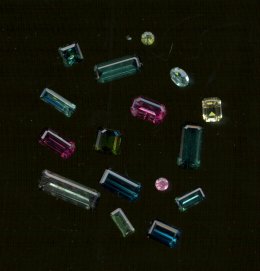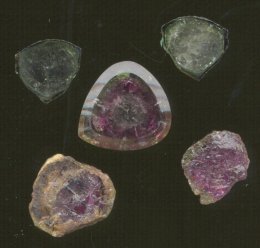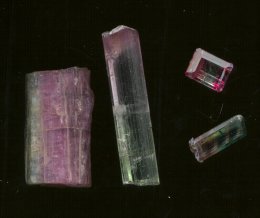If you were born in October, you are one of those people who has a choice for your birthstone. Opal was originally the gem trade's recognized birthstone for October but in 1952 the Jewelry Industry Council suggested that pink tourmaline be an alternate stone to opal. These changes were accepted and approved by the American Gem Society and the National Retail Jewelers Council. Although the original designation for tourmaline was pink tourmaline, the practice has become that many people accept tourmaline of any color for October's birthstone. Tourmaline comes in nearly every shade one can find on a color chart or color wheel---therefore, tourmaline has become a popular stone in recent years.
Tourmaline derives its name from the Singalese word tourmali, which means "mixed stones." Ruby, sapphire, peridot and spinel have all been found together in the gravel of localities such as Sri Lanka and Burma. The early gem traders who had no idea about the optical and physical properties of gems, other than color, probably called red tourmaline ruby; blue tourmaline sapphire; green tourmaline peridot, etc. Modern gem testing equipment has enabled gemologists to differentiate between all of these stones and it was with development of optical gem testing techniques that the gemological properties of fine tourmaline were made known to the world.
Tourmaline is a complex silicate of Boron and Aluminum. Many different elements are able to find a spot for substitution in the crystal lattice and this accounts for all of the different colors of tourmaline that are available to the gem fancier. It would be difficult to write down a neat and easy formula for tourmaline because of the numerous possible substitutions that can take place within the crystal. In the past names such as rubellite and indicolite were used for red and blue tourmaline respectively. Since the mineral suffix ite implies each are a different mineral, it is now preferable to use the terms red tourmaline and blue tourmaline, etc.
Tourmaline's many color variations make it an example for another kind of mis-labeling. For example, one will sometimes see the usage of names such as Brazilian sapphire or Brazilian emerald for blue and green tourmaline respectively. Such names confuse the potential buyer into thinking the stone is something other than what it really is.
Tourmaline is fairly easy to identify. Finished stones have a soft luster and the two refractive indexes, 1.620 and 1.640 allow for some doubling of back facets and inclusions in the stone. Tourmaline may also show some long tubes that are oriented parallel to the c-axis of the crystal. The typical tourmaline crystal is long and sub-triangular in cross section and the outer surface is usually deeply striated. The lapidary must orient the stone such table of the stone is parallel to the c-axis of the crystal. Tourmaline absorbs light along the c-axis of the crystal and if the table is perpendicular to that axis, the stone will develop a very dark body color. If you have a transparent tourmaline crystal available, look at it from directions that are perpendicular to the c-axis and parallel to the c-axis. The effect will be striking.
Tourmaline may show a couple of different phenomena: watermelon tourmaline and particolor tourmaline. In the former, the outer layer of the crystal is green and the inner part of the crystal is red and there may be small black inclusions that resemble black seeds similar to a cross section of watermelon. The distinction is now used for any tourmaline that has an outer layer of the crystal with one color and an interior of another. These color variations may be brought about by varying concentrations of metallic cations that that were favored in crystallization of tourmaline from a solution or melt.
In the United States tourmaline has been found in Maine, North Carolina, and California. The Black Hills of South Dakota have produced some finely colored blue stones that have been rarely used for gems because of small size and many tiny fractures. Brazil has produced many fine tourmaline crystals of many colors that have found use both as cut gems and as museum specimens. Namibia, Nigeria and Zambia in Africa have produced some fine gem tourmaline in recent years.
For Further Reading
- Johnson, M. L., and Koivula, J. I., (editors) 1998. Another tourmaline source in Namibia. In: Colored Stones. In Gem News, Gems and Gemology, Winter, 1998, p.54.
- Johnson, M. L., and Koivula, J. I., (editors) 1998. Red, pink and bicolored tourmaline from Nigeria. In: Colored Stones. In Gem News, Gems and Gemology, Winter, 1998, p.298-299.
- Liddicoat, R. T., 1969. Handbook of Gem Identification. Gemological Institute of America, Los Angeles, CA, 430 p.
- Schumann, W., 1977. Gemstones of the World. Sterling Publishing Co., New York, 256 p.
- Shipley, R. M., 1971. Dictionary of Gems and Gemology. Gemological Institute of America, Los Angeles, CA, 230 p.
- Zeitner, J. C., 1996. Gem and Lapidary Materials for Cutters, Collectors, and Jewelers. Geoscience Press, Tucson, AZ, 347 p.


